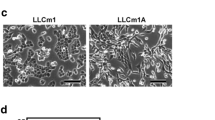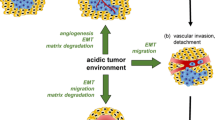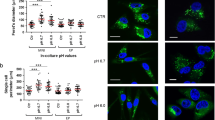As a consequence of poor perfusion and elevated acid production, the extracellular pH (pHex) of tumors is generally acidic. Despite this, most in vitro experiments are still performed at the relatively alkaline pHex of 7.4. This is significant, because slight changes in pHex can have profound effects on cell phenotype. In this study we examined the effects of mildly acidic conditions on the in vitro invasive potential of two human melanoma cell lines: the highly invasive C8161, and poorly invasive A375P. We observed that culturing of either cell line at acidic pH (6.8) caused dramatic increases in both migration and invasion, as measured with the Membrane Invasion Culture System (MICS). This was not due to a direct effect of pH on the invasive machinery, since cells cultured at normal pH (7.4) and tested at acidic pH did not exhibit increased invasive potential. Similarly, cells cultured at acidic pH were more aggressive than control cells when tested at the same medium pH. These data indicate that culturing of cells at mildly acidic pH induces them to become more invasive. Since acid pH will affect the intracellular pH (pHin) and intracellular calcium ([Ca2+]in), we examined the effect of these parameters on invasion. While changes in [Ca2+]inwere not consistent with invasive potential, the changes in pHin were. While these conditions decrease the overall amount of gelatinases A and B secreted by these cells, there is a consistent and significant increase in the proportion of the activated form of gelatinase B.
Similar content being viewed by others
References
Wike-Hooley, JL, Haveman, J and Reinhold, HS, 1991, The relevance of tumour pH to the treatment of malignant disease. Radiother Oncol, 2,343–66.
Grifiths, JR, 1991, Are cancer cells acidic? Br J Cancer, 64,425–7.
Gillies, RJ, Liu, Z and Bhujwalla, ZM, 1994, 31P NMR measurement of extracellular pH in situ using 3-aminopropylphosphonate. Am J Physiol, 267 (Cell Physiology 36), C195-C203.
Warburg O, 1926, Über den Stoffwechsel der Tumoren. Cambridge University Press.
Sevick, EM and Jain, RK, 1988, Blood flow and venous pH of tissue-isolated Walker 256 carcinoma during hyperglycemia. Cancer Res, 48, 1201–7.
Vaupel, P, Kallinowski, F and Okunieff, P, 1989, Blood flow, oxygen and nutrient supply, and metabolic microenvironment. Cancer Res, 49, 6449–65.
Stolk JA, Bhujwalla ZM, Blackband SJ, Shungu DC, Wehrle JP and Glickson JD, 1991, Quantitative in vivo measurement of blood flow in RIF-1 tumors by 1H/2H NMR spectroscopy. Proc 10th Ann Mtg Soc Magn Reson Med, p. 984.
Bhujwalla, ZM, Tozer, GM, Feld, SB, Maxwell, RJ and Grifths, JR, 1990, Energy metabolism of RIF-1 tumors following hydralazine. Radiother Oncol, 19, 281–91.
Hendrix, MJC, Seftor, EA, Seftor, REB and Fidler, IJ, 1987, A simple quantitative assay for studying the invasive potential of high and low human metastatic variants. Cancer Lett, 38, 137–47.
Schlappack, OK, Zimmermann, A and Hill, RP, 1991, Glucose starvation and acidosis: effect on experimental metastasic potential, DNA content and MTX resistance of murine tumour cells. Int J Cancer, 64, 663–70.
Stetler-Stevenson, WG, 1990, Type IV collagenases in tumor invasion and metastasis. Cancer Metastasis Rev, 9, 289–303.
Nicolson, GL, 1992, Paracrine/autocrine growth mechanisms in tumor metastasis. Oncol Res, 4, 389–99.
Miller, FR and Heppner, GH, 1990, Cellular interactions in metastasis. Cancer Metastasis Rev, 9,21–34.
Fidler, IJ, 1991, Cancer metastasis. Br Med Bull, 47, 157–77.
Lah, TT, Kokalj-Kunovar, M, Strukelj, B, et al. 1992, Stefins and lysosomal cathepsins B, L and D in human breast carcinoma. Int J Cancer, 50, 36–44.
Matrisian, LM, 1992, The matrix-degrading metalloproteinases. Bioessays, 14,455–63.
Tryggvason, K, Hoyhtya, M and Pyke, C, 1993, Type IV collagenases in invasive tumors. Breast Canc Res Treat, 24, 209–18.
Vassalli, J-D, Sappino, AP and Belin, D, 1991, The plasminogen activator/plasmin system. J Clin Invest, 88, 1067–72.
Vassalli, J-D and Pepper, MS, 1994, Membrane proteases in focus. Nature, 370, 14–15.
Morisset, M, Capony, F and Rochefort, H, 1986, The 52-kDa estrogen-induced protein secreted by MCF-7 cells is a lysosomal acidic protease. Biochim Biophys Res Commun, 138, 102–9.
Rozhin, J, Sameni, M, Siegler, G and Sloane, BF, 1994, Pericellular pH affects distribution and secretion of cathepsin B in malignant cells. Cancer Res, 54, 6517–25.
Kramer, MD, Robinson, P, Vlodavsky, I, et al. 1985, Characterization of an extracellular matrix-degrading protease derived from a highly metastatic tumor cell line. Eur J Cancer Clin Oncol, 21, 307–16.
Ishihara, A, Nabeshima, K and Koono, M, 1986, Partial purification and characterization of serum protease from tumor-bearing rats which cleaves type IV collagen. Invasion & Metastasis, 6,225–45.
Slivka, SR and Loskutoff, DJ, 1991, Platelets stimulate endothelial cells to synthesize type 1 plasminogen activator inhibitor. Evaluation of the role of transforming growth factor beta. Blood, 77, 1013–19.
Kato, Y, Nakayama, Y, Umeda, M and Miyazaki, K,1992, Induction of 103-kDa gelatinase/type IV collagenase by acidic culture conditions in mouse metastatic melanoma cell lines. J Biol Chem, 267, 11424–30.
Baker, MS, Liang, XM and Doe, WF, 1992, Occupancy of the cancer cell urokinase receptor (uPAR): effects of acid elution and exogenous uPA on cell surface urokinase (uPA). Biochim Biophys Acta, 1117, 143–52.
Uchino, T, Sakurai, Y, Nishigai, M, et al. 1993, Isolation and characterization of a novel serine proteinase complexed with alpha 2-macroglobulin from porcine gastric mucosa. J Biol Chem, 268,527–33.
Hendrix, MJC, Seftor, EA, Chu, Y-W, et al. 1992, Coexpression of vimentin and keratins by human melanoma tumor cells: correlation with invasive and metastasic potential. J Natl Cancer Inst, 84, 165–74.
Chu, Y-W, Duffy, JJ, Seftor, REB, Nagle, RB and Hendrix, MJC, 1991, Transfection of a deleted CK 18 cDNA into a highly metastatic melanoma cell line decreases the invasive potential. Clin Biotech, 3,27–33.
Schwartz, MA, Both, G and Lechene, C, 1989, Effect of cell spreading on cytoplasmic pH in normal and transformed fibroblasts. Proc Natl Acad Sci USA, 86,4525–9.
Stossel, TP, 1989, From signal to pseudopod. How cells control cytoplasmic actin assembly. J Biol Chem, 264, 18261–4.
Soifer, D, 1986, Dynamic aspects of microtubule biology. Ann NY Acad Sci, 466,1–978.
Martínez-Zaguilán, R, Martinez, GM, Lattanzio, F and Gillies, RJ, 1991, Simultaneous measurement of intracellular pH and Ca2+ using the fluorescence of SNARF-1 and Fura-2. Am J Physiol, 260, C297-C307.
Degen, DL, Estensen, RD, Nagamine, Y and Reich, E, 1985, Induction and desensitization of plasminogen activator gene expression by tumor promoters. J Biol Chem, 260,12426–33.
Angel, P, Baumann, I, Stein, B, Delius, H, Rahmsdorf, HJ and Herrlich, P, 1987, 12-O-Tetradecanoyld-phorbol-l3acetate induction of the human collagenase gene is mediated by an inducible enhancer element located in the 5′-flanking region. Molec Cell Biol, 7, 2256–66.
Frisch, SM, Clark, EJ and Werb, Z, 1987, Coordinate regulation of stromelysin and collagenase genes determined with cDNA probes. Proc Natl Acad Sci, USA, 84,2600–4.
Edwards, DR, Waterhouse, P, Holman, LM and Denhardt, DT, 1986, A growth factor-inducible gene (16C8) in mouse fibroblasts is homologous to human tissue inhibitor of metalloproteinases. Nucl Acid Res, 14, 8863–78.
Murphy, G and Reynolds, JJ, 1985, Biosynthesis of tissue inhibitor of metalloproteinases by human fibroblasts in culture. Stimulation by 12-O-tetradecanoylphorbol 13-acetate and interleukin-1 in parallel with collagenase. J Biol Chem, 260, 3079–83.
Korczak, B, Whale, C and Kerbel, RS, 1989. Possible involvement of Ca2+ mobilization and protein kinase C induction of spontaneous metastasis by mouse mammary adenocarcinoma cells. Cancer Res, 49, 2597–602.
Brinckerhoff, CE, Plucinska, I, Sheldon, L and O'Connor, GT, 1986, Half-life of synovial cell collagenase mRNA is modulated by phorbol myristate acetate but not by all-trans-retinoic acid or dexamethasone. Biochemistry, 25,6378–84.
Takenaga, K and Takahashi, K, 1986, Effects of 12-O-tetradecanoylphorbol-13-acetate on adhesiveness and lung-colonization ability of Lewis lung carcinoma cells. Cancer Res, 40, 375–80.
Gopalakrishna, R and Barsky, SH, 1988, Tumorpromoter induced membrane-bound kinase C regulates hematogenous metastasis. Proc Natl Acad Sci, USA, 85, 612–16.
Whitfield, JF, Durkin, JP, Franks, DJ, et al. 1987, Calcium, cyclic AMP and protein kinase C: partners in mitogenesis. Cancer Metastasis Rev, 5, 205–50.
Barbero, MC, Garcia, M, Almena, A and Alino, SF, 1991, Correlation between secretion pattern and metastatic potential from drug-treated 3LL tumor cells line. Cell Molec Biol, 37,501–8.
Moolenaar, WH, 1986, Effects of growth factors on intracellular pH regulation. Ann Rev Physiol, 48,363–76.
Berridge, MJ, 1987, Inositol triphosphate and diacyl glycerol: two interacting second messengers. Ann Rev Biochem, 56,156–93.
Vincentini, LM and Villarreal, ML, 1986, Inositol phosphate turnover, cytosolic Ca2+ and pH: putative signals for the control of cell growth. Life Sci, 38, 2269–76.
Rozengurt, E, 1986, Early signals in the mitogenic response. Science, 234,161–6.
Hesketh, TR, Moore, JP, Morris, JDH, et al., 1985, A common sequence of calcium and pH signals in the mitogenic stimulation of eukaryotic cells. Nature, 313, 481–4.
Gillies, RJ, Martinez, R, Sneider, JM and Hoyer, PB,1989, Sphingosine inhibits phorbol 12-myristate 13-acetate-, but not serum-induced, activation of Na+/H+ exchange in mammalian cells. J Cell Physiol, 139,125–30.
Mareel, MM, Van Roy, FM and De Baetselier, P, 1990, The invasive phenotype. Cancer Metastasis Rev, 9, 45–62.
Marks, PW and Maxfield, FR, 1990, Transient increases in cytosolic free calcium appear to be required for the migration of adheren Ca2+ trt human neutrophils. J Cell Biol, 110, 43–52.
Milne, JL and Coukell, MB, 1991, A transport system associated with the plasma membrane of Dictyostelium discoideum is activated by different chemoattractant receptors. J Cell Biol, 112, 103–10.
Savarese, DM, Russell, JT, Fatatis, A and Liotta, LA, 1992, Type IV collagen stimulates an increase in intracellular calcium. Potential role in tumor cell motility. J Biol Chem, 267,21928–35.
Martinez-Zaguilán, R, 1992, Measurements of intracellular Ca 2+ and pHin in cultured cells by fluorescence spectroscopy. In: Watson, RR, ed. In Vitro Methods of Toxicology. Boca Raton, FL: CRC Press, pp. 217–36.
Kleinman, HK, McGarvey, ML, Liotta, LA, et al., 1982, Isolation and characterization of type IV procollagen, laminin and heparan sulfate proteoglycan from the EHS sarcoma. Biochemistry, 21, 6188–93.
Bregman, MD, Peters, E, Sander, D and Meyskens, FL Jr, 1983, Dexamethasone, prostaglandin A, and retinoic acid modulation of murine and human melanoma cells grown in soft agar. J Natl Cancer Inst, 71, 927–32.
Gillies, RJ, Martinez-Zaguilán, R, Martinez, GM, Serrano, R and Perona, R, 1990, Tumorigenic 3T3 cells maintain an alkaline intracellular pH under physiological conditions. Proc Natl Acad Sci, USA, 87, 7414–18.
Lattanzio, FA, 1990, The effects of pH and temperature on fluorescent calcium indicators as determined with chelex-100 and EDTA buffer systems. Biochem Biophys Res Commun, 171,102–8.
Wiegmann, TB, Welling, LW, Beatty, DM, Howard, DE, Vamos, S and Morris, SJ, 1993, Simultaneous imaging of intracellular [Ca2+] and pH in single MDCK and glomerular epithelial cells. Am J Physiol, 265, C1184-C1190.
Gillies, RJ, Didier, N and Denton, M, 1986, Determination of cell number in monolayer cultures. Analyt Biochem, 159,109–13.
Matrisian, LM, 1990, Metalloproteinases and their inhibitors in matrix remodeling. Trends Genetics, 6, 121–5.
Woessner, JF, 1991, Matrix metalloproteinases and their inhibitors in connective tissue remodeling. FASEB J, 5, 2145–54.
Duffy, MJ, 1992, The role of proteolytic enzymes in cancer invasion and metastasis. Clin Exp Metastasis, 10, 145–55.
Seftor, REB, 1994, Electrophoretic analysis of proteins associated with tumor cell invasion. Electrophoresis, 15, 454–62.
Khandjian, EW, 1990, Acidic extracellular environment induces only a subset of heat-shock proteins in primary mouse kidney cell cultures. Biochem Cell Biol, 68, 804–7.
Mosser, DD, Kotzbauer, PT, Sarge, KD and Morimoto, RI, 1990, In vitro activation of heat shock transcription factor DNA-binding by calcium and biochemical conditions that affect protein conformation. Proc Natl Acad Sci, USA, 87, 3748–52.
LeBoeuf, RA, Kerckaert, GA, Aardema, MJ and Gibson, DP, 1990, Multistage neoplastic transformation of Syrian hamster embryo cells cultured at pH 6.7. Cancer Res, 50, 3722–9.
Author information
Authors and Affiliations
Rights and permissions
About this article
Cite this article
Martínez-Zaguilán, R., Seftor, E.A., Seftor, R.E.B. et al. Acidic pH enhances the invasive behavior of human melanoma cells. Clin Exp Metast 14, 176–186 (1996). https://doi.org/10.1007/BF00121214
Received:
Accepted:
Issue Date:
DOI: https://doi.org/10.1007/BF00121214




